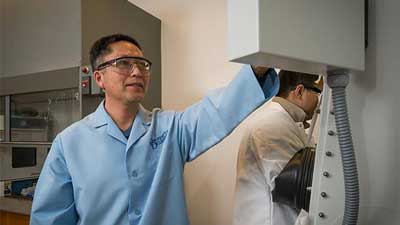| Posted: Mar 06, 2017 |
A new approach to improving lithium-sulfur batteries
(Nanowerk News) Rechargeable lithium-ion batteries are the power behind most modern portable electronics, including cell phones, tablets, laptops, fitness trackers, and smart watches. However, their energy density -- that is, the amount of energy stored within a given amount of physical space, or mass -- will need to be improved for these batteries to see widespread use in smart grid and electric transport applications.
|
|
In contrast, the energy density of lithium-sulfur (Li-S) batteries is five times higher than that of Li-ion batteries. That advantage, combined with low cost, suggests that this alternative technology shows promise for high-energy storage applications.
|
|
But the use of Li-S batteries is limited by a different problem: rapid capacity fade, which means that the amount of charge these batteries can deliver at the rated voltage decreases significantly with use.
|
|
Bingqing Wei, professor in the Department of Mechanical Engineering at the University of Delaware, explains that this problem stems from a phenomenon known as the polysulfide shuttle effect, in which the spontaneous formation of polysulfides inhibits performance.
|
 |
| Bingqing Wei and colleagues are working to build a better lithium-sulfur battery.
|
|
Now, Wei and colleagues have demonstrated a new polysulfide entrapping strategy that greatly improves the cycle stability of Li-S batteries.
|
|
The work is reported in the scientific article "Ferroelectric-Enhanced Polysulfide Trapping for Lithium-Sulfur Battery Improvement" published recently in Advanced Materials ("Ferroelectric-Enhanced Polysulfide Trapping for Lithium–Sulfur Battery Improvement"). The authors include researchers from Northwestern Polytechnical University, Shenzhen University and Hong Kong Polytechnic University in China.
|
|
Wei explains that the addition of ferroelectric nanoparticles into the battery cathode anchors the polysulfides, preventing them from dissolving and causing the loss of active materials at the cathode.
|
|
"While the mechanism underlying the trapping of polysulfides is unclear at this point, we're optimistic about the potential of this approach to high-performance lithium-sulfur battery applications, as it not only solves the problem of the polysulfide shuttle effect but also can be seamlessly coupled to current industrial battery manufacturing processes," Wei says.
|

